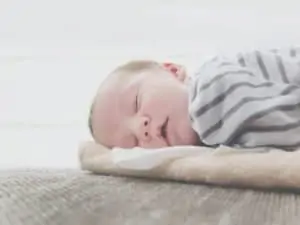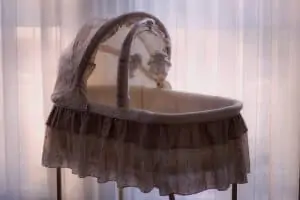Have you ever laid your baby down, and then your baby startles awake? That’s the startle reflex, called the Moro Reflex, and it’s far from a parent’s best friend. This survival reflex might serve a purpose, but it is considerably harder to lay your baby down to sleep.
Loud noises and sudden movements cause your baby to respond. The infant startle reflex causes your baby to suddenly throw his arms and legs out, arch his back, then relax again. Some babies cry when this happens but not always.
Sound familiar? All babies have the Moro Reflex, and we can be thankful that it doesn’t last forever. Let’s keep reading about the infant startle reflex to help you know what to expect.
Why Do Babies Startle in Their Sleep?

One minute, your baby peacefully sleeps, and the next minute, your baby gets scared for no reason. It’s not uncommon for a baby to startle in their sleep.
All babies are born with several normal infant reflexes, and the Moro Reflex is one of those. While it’s frustrating because it often wakes your baby, there is no way to truly prevent the Moro Reflex from occurring. It’s healthy for your baby to display this reflex because it showcases your baby’s properly developing nervous system.
Doctors aren’t entirely sure why babies have this reflex. It’s believed that it’s for self-preservation or to help alert babies to danger, but it’s impossible to be sure.
What Triggers the Startle Reflex
So, what causes the newborn to startle reflex while sleeping?
Any sudden changes trigger this reflex due to sensual stimulation. There are many triggers, but here are the most common:
- Loud noises
- Sudden touches
- Abrupt changes in light intensity
- Events that put your baby off balance
- Change in direction
When Do Babies Grow Out of the Startle Reflex?
Every parent wonders at some point how long does the startle reflex last; you’re tired of your baby’s hyperactive Moro reflex waking him during each nap.
This reflex is most common in newborn babies; you’ll notice it immediately with your new baby. As time passes, the reflex improves and completely disappears by five to six months old. You might feel your baby’s startle reflex is returning periodically, but it’s a sign of his nervous system developing.
Here are the stages when babies lose the startle reflex.
- Birth to One-Month-Old
Babies are born with the Moro Reflex. It helps your baby learn how to cope and handle all the brand-new stimuli in the real world; womb life was much calmer.
- Two Months to Four Months Old
It’s not uncommon for an exaggerated startle reflex at two months old. At this age, babies are still developing, including their nervous system, and their eyesight improves, allowing them to see more around them.
- Four to Six Months Old
It might seem like your baby’s startle reflex is getting worse at four months, but chances are it looks worse because your baby is stronger, and swaddling should be stopped by now. That makes all of his movements seem worse, but don’t worry. The start reflex goes away from six months old. By five months old, it should be on its way out.
What If My Baby Doesn’t Lose His Startle Reflex?
Some babies take longer to lose this reflex; it all depends on their nervous system’s development. If it continues beyond six months, talk to your pediatrician. In some circumstances, a retained Moro Reflex might be due to trauma, injury, or nervous system problems.
How Can I Help My Baby Sleep with The Startle Reflex?
Sleep is necessary for infants, but dealing with an overactive startle reflex in your baby is hard. Here are some ideas to reduce how often your baby startles awake.
Don’t Lay Your Baby Down Too Soon
Your baby likes to be connected to you; being separate doesn’t feel quite right. Laying down your baby to sleep too soon leads to the startle reflex, especially if you have to lean over a crib. Wait until your baby is fully asleep and his body relaxes before transitioning.
Once you lay your baby down, stay close for a few minutes. That might be continuing a gentle pat or keeping a hand on your baby’s chest before gently pulling away. Be patient because moving away too early will wake up your baby.
Keep a Bedtime Routine
Establishing a bedtime routine is important; it gives your baby consistency and predictability, significantly improving sleep. Set a specific bedtime and stick to it.
Create a routine that works for you that isn’t too complicated. As your baby ages, expect that you might need to deviate at times, so keeping it simple works.
Create a Sleepy Environment

Babies need a sleepy environment. Make sure the room is dark without any screens or street lights shining into the room. It should be quiet and a comfortable temperature, around 68℉.
Make sure your baby sleeps on a flat, firm surface. That’s the safest environment for your baby; keep all blankets out of the crib as well.
Swaddle Your Baby
Most parents turn to swaddling to help with the startle reflex. Swaddling creates a womb-like environment that prevents your baby’s movements; he won’t be able to scare himself away. It helps your baby feel safe like he did in the womb.
Some babies don’t like to be swaddled too tightly or have their arms restricted too tightly. In those situations, try buying a transition swaddle that lets your baby stretch his legs and arms out while still being comfortably wrapped.
Final Thoughts
While getting your baby to sleep might be frustrating, the baby startle reflex is a normal part of development. By the time he is six months old, the reflex should be gone. Use simple tricks like swaddling and patience while waiting for your baby to fall asleep to reduce how often the startle reflex wakes him up.
Hey, this is Linda. My biggest accomplishment in life is being a mother of four children. Their current ages range from almost ten years old down to 20 months old.
I’m passionate about writing parenting articles because I understand so well all of the problems and trials you face as a parent. From breastfeeding woes to budgeting problems and behavior problems, along with everything in between, chances are I’ve faced it over the last ten years. Read more about Linda here.






